TOYOTA YARIS HATCHBACK 2020 (in English) Repair Manual
Manufacturer: TOYOTA, Model Year: 2020, Model line: YARIS HATCHBACK, Model: TOYOTA YARIS HATCHBACK 2020Pages: 572, PDF Size: 7.94 MB
Page 61 of 572
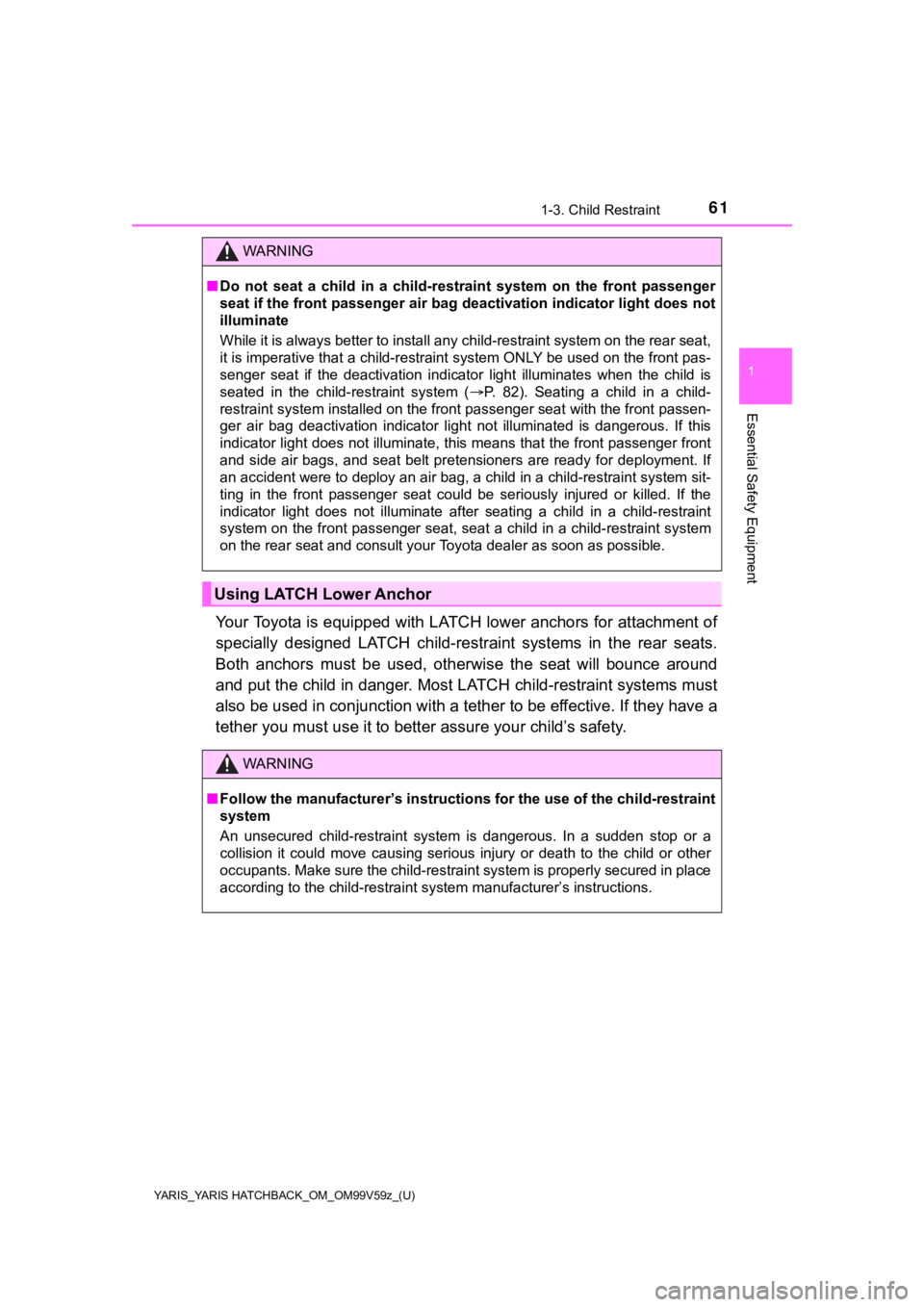
YARIS_YARIS HATCHBACK_OM_OM99V59z_(U)
611-3. Child Restraint
1
Essential Safety Equipment
Your Toyota is equipped with LATCH lower anchors for attachment of
specially designed LATCH child-re straint systems in the rear seats.
Both anchors must be used, otherwise the seat will bounce aroun d
and put the child in danger. Most LATCH child-restraint systems must
also be used in conjunction wi th a tether to be effective. If they have a
tether you must use it to better assure your child’s safety.
WARNING
■ Do not seat a child in a child-r estraint system on the front passenger
seat if the front passenger air ba g deactivation indicator light does not
illuminate
While it is always better to install any child-restraint system on the rear seat,
it is imperative that a child-restraint system ONLY be used on the front pas-
senger seat if the deactivation indicator light illuminates when the child is
seated in the child-restraint system ( P. 82). Seating a child in a child-
restraint system installed on the front passenger seat with the front passen-
ger air bag deactivation indicator light not illuminated is dangerous. If this
indicator light does not illuminate, this means that the front passenger front
and side air bags, and seat belt pretensioners are ready for deployment. If
an accident were to deploy an air bag, a child in a child-restr aint system sit-
ting in the front passenger seat could be seriously injured or killed. If the
indicator light does not illuminate after seating a child in a child-restraint
system on the front passenger seat, seat a child in a child-res traint system
on the rear seat and consult your Toyota dealer as soon as poss ible.
Using LATCH Lower Anchor
WARNING
■Follow the manufacturer’s instructions for the use of the child-restraint
system
An unsecured child-restraint system is dangerous. In a sudden s top or a
collision it could move causing serious injury or death to the child or other
occupants. Make sure the child-restraint system is properly sec ured in place
according to the child-restraint system manufacturer’s instructions.
Page 62 of 572
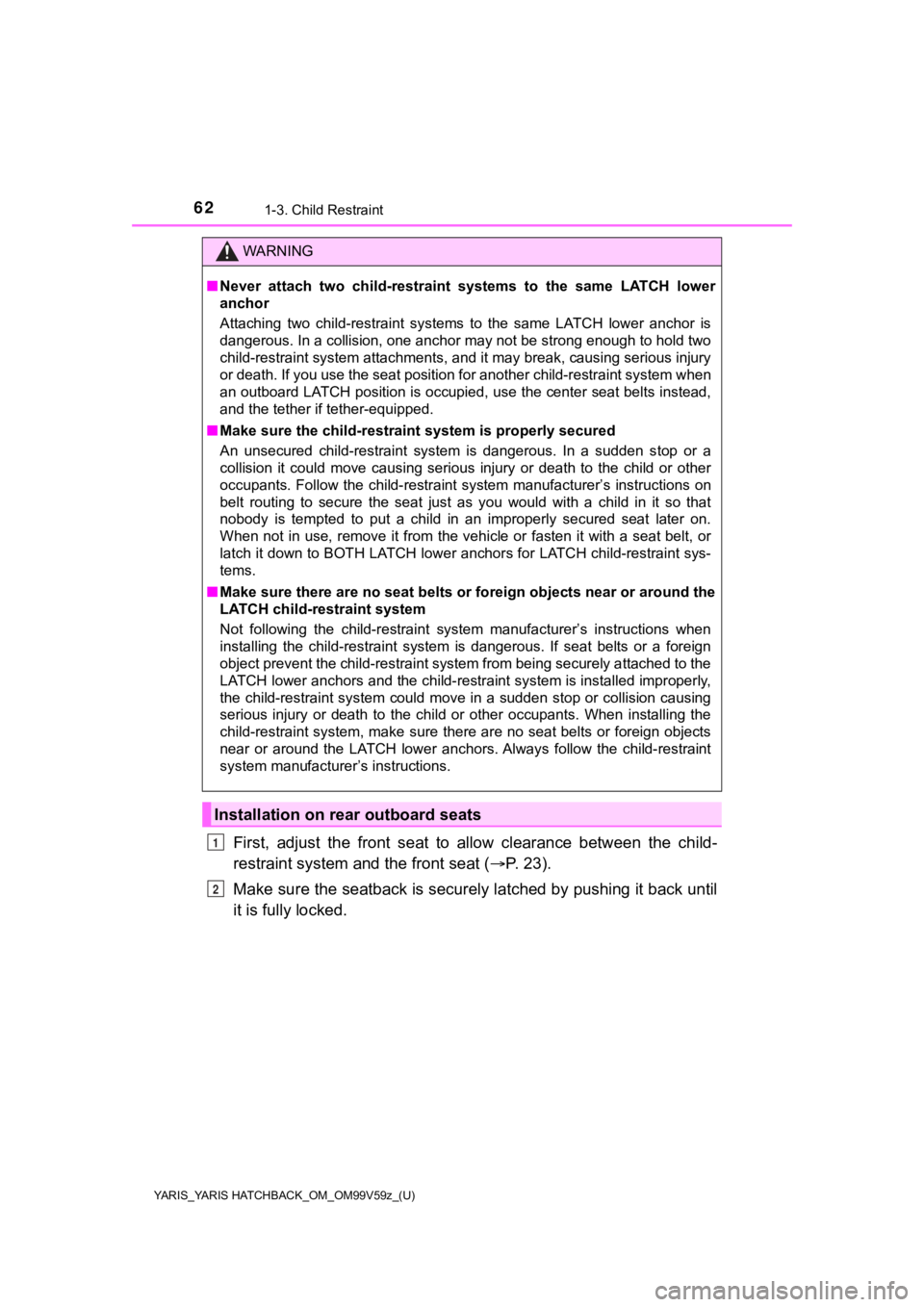
62
YARIS_YARIS HATCHBACK_OM_OM99V59z_(U)
1-3. Child Restraint
First, adjust the front seat to allow clearance between the chi ld-
restraint system and the front seat ( P. 2 3 ) .
Make sure the seatback is securely latched by pushing it back u ntil
it is fully locked.
WARNING
■ Never attach two child-restraint systems to the same LATCH lowe r
anchor
Attaching two child-restraint systems to the same LATCH lower a nchor is
dangerous. In a collision, one anchor may not be strong enough to hold two
child-restraint system attachments, and it may break, causing s erious injury
or death. If you use the seat position for another child-restra int system when
an outboard LATCH position is occupied, use the center seat bel ts instead,
and the tether if tether-equipped.
■ Make sure the child-restraint system is properly secured
An unsecured child-restraint system is dangerous. In a sudden s top or a
collision it could move causing serious injury or death to the child or other
occupants. Follow the child-restraint system manufacturer’s ins tructions on
belt routing to secure the seat just as you would with a child in it so that
nobody is tempted to put a child in an improperly secured seat later on.
When not in use, remove it from the vehicle or fasten it with a seat belt, or
latch it down to BOTH LATCH lower anchors for LATCH child-restr aint sys-
tems.
■ Make sure there are no seat belts or foreign objects near or ar ound the
LATCH child-restraint system
Not following the child-restraint system manufacturer’s instructions when
installing the child-restraint system is dangerous. If seat bel ts or a foreign
object prevent the child-restraint system from being securely a ttached to the
LATCH lower anchors and the child-restraint system is installed improperly,
the child-restraint system could move in a sudden stop or colli sion causing
serious injury or death to the child or other occupants. When i nstalling the
child-restraint system, make sure there are no seat belts or fo reign objects
near or around the LATCH lower anc hors. Always follow the child-restraint
system manufacturer’s instructions.
Installation on rear outboard seats
1
2
Page 63 of 572

YARIS_YARIS HATCHBACK_OM_OM99V59z_(U)
631-3. Child Restraint
1
Essential Safety Equipment
Expand the open seams on the
rear of the seat bottom slightly
to verify the locations of the
LATCH lower anchors.
The markings above the LATCH
lower anchors indicate the loca-
tions of the LATCH lower anchors
for the attachment of a child-
restraint system.
Remove the head restraint.
Refer to Head Restraints on P. 30.
Secure the child-restraint system using BOTH LATCH lower
anchors, following the child-restraint system manufacturer’s instruc-
tion. Pull on the child-restraint to be sure both anchors are
engaged.
If your child-restraint system came equipped with a tether, tha t
means it is very important to properly secure the tether for ch ild
safety. Please carefully follow the child-restraint system manu fac-
turer’s instructions w hen installing tethers.
3
WARNING
■Use the tether and tether anchor only for a child-restraint system
Using the tether or tether anchor to secure anything but a chil d-restraint
system is dangerous. This could weaken or damage the tether or tether
anchor and result in injury.
■ Always remove the head restraint and install child-restraint sy stem
Installing a child-restraint system without removing the head restraint is
dangerous. The child-restraint system cannot be installed corre ctly which
may result in death or injury to the child in a collision.
4
5
6
4-Door5-Door
Tether strap
Anchor bracket
Tether strap
Forward
Page 64 of 572
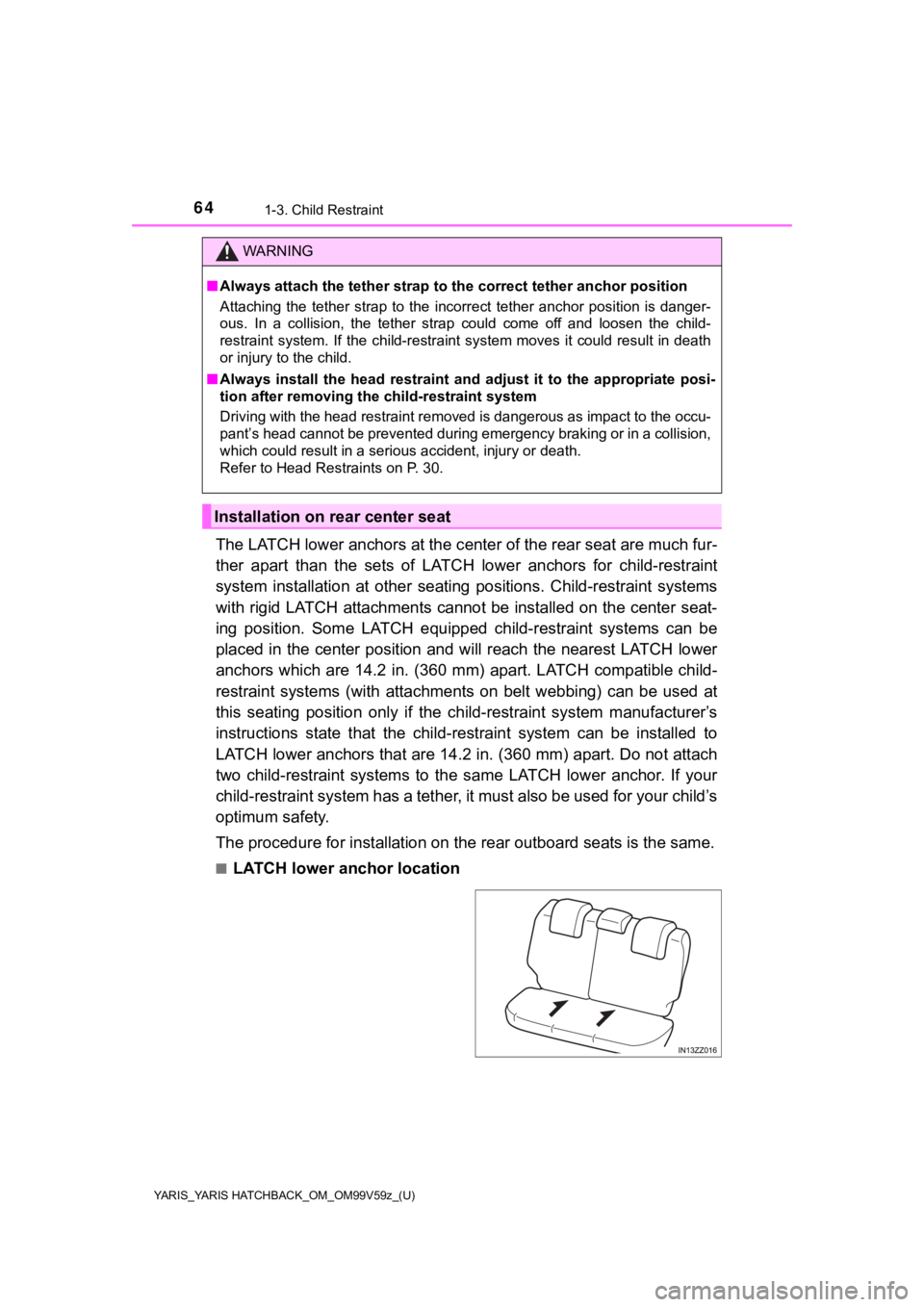
64
YARIS_YARIS HATCHBACK_OM_OM99V59z_(U)
1-3. Child Restraint
The LATCH lower anchors at the center of the rear seat are much fur-
ther apart than the sets of LATCH lower anchors for child-restr aint
system installation at other seating positions. Child-restraint systems
with rigid LATCH attachments cannot be installed on the center seat-
ing position. Some LATCH equipped child-restraint systems can b e
placed in the center position and will reach the nearest LATCH lower
anchors which are 14.2 in. (360 mm) apart. LATCH compatible chi ld-
restraint systems (with attachments on belt webbing) can be use d at
this seating position only if the child-restraint system manufacturer’s
instructions state that the child-restraint system can be installed to
LATCH lower anchors that are 14.2 in. (360 mm) apart. Do not at tach
two child-restraint systems to the same LATCH lower anchor. If your
child-restraint system has a tethe r, it must also be used for your child’s
optimum safety.
The procedure for installation on the rear outboard seats is th e same.
■LATCH lower anchor location
WARNING
■Always attach the tether strap to the correct tether anchor pos ition
Attaching the tether strap to the incorrect tether anchor position is danger-
ous. In a collision, the tether strap could come off and loosen the child-
restraint system. If the child-restraint system moves it could result in death
or injury to the child.
■ Always install the head restraint and adjust it to the appropriate posi-
tion after removing the child-restraint system
Driving with the head restraint removed is dangerous as impact to the occu-
pant’s head cannot be prevented during emergency braking or in a collision,
which could result in a serious accident, injury or death.
Refer to Head Restraints on P. 30.
Installation on r ear center seat
Page 65 of 572
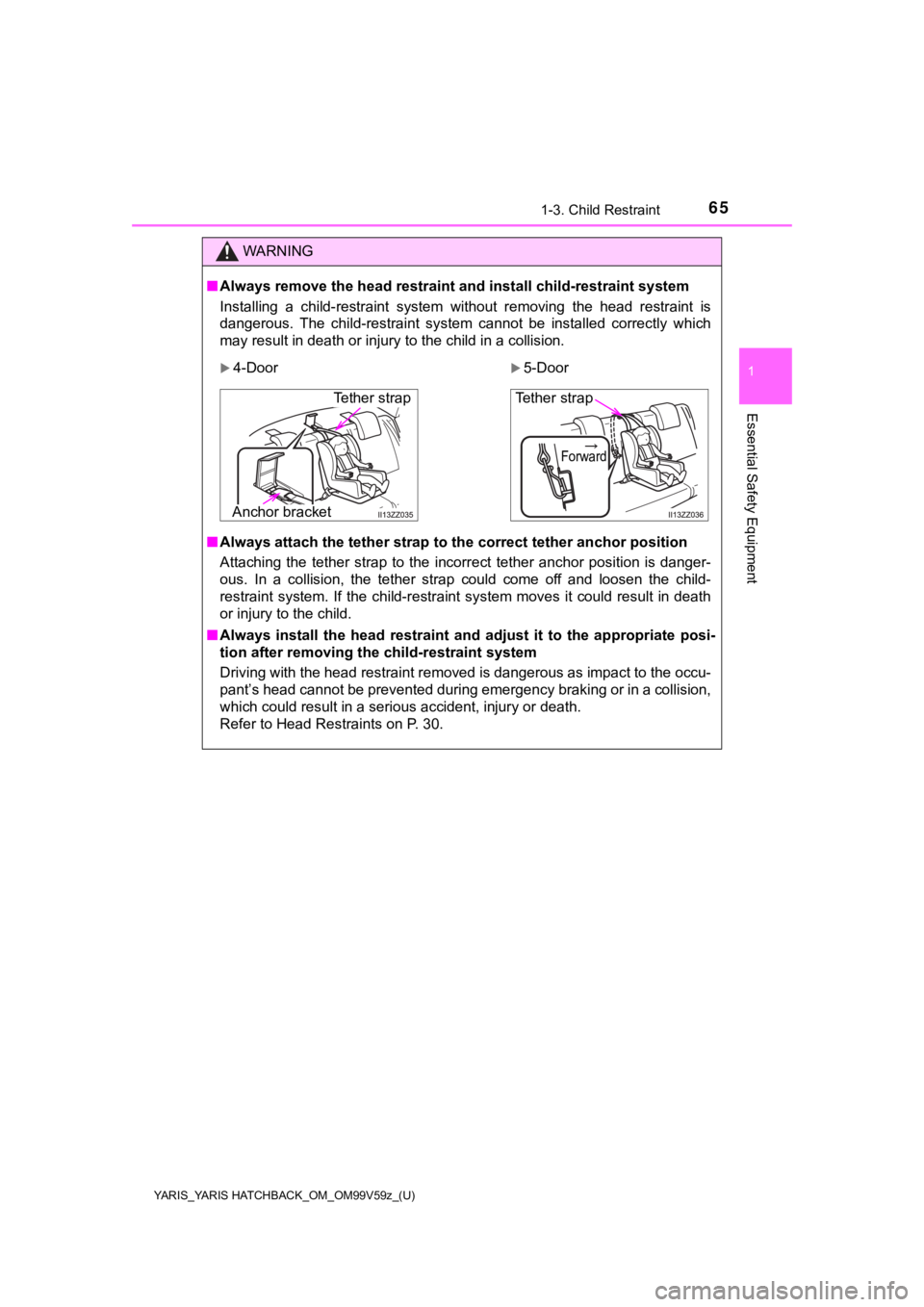
YARIS_YARIS HATCHBACK_OM_OM99V59z_(U)
651-3. Child Restraint
1
Essential Safety Equipment
WARNING
■Always remove the head restraint and install child-restraint sy stem
Installing a child-restraint system without removing the head restraint is
dangerous. The child-restraint system cannot be installed corre ctly which
may result in death or injury to the child in a collision.
■ Always attach the tether strap to the correct tether anchor pos ition
Attaching the tether strap to the incorrect tether anchor position is danger-
ous. In a collision, the tether strap could come off and loosen the child-
restraint system. If the child-restraint system moves it could result in death
or injury to the child.
■ Always install the head restraint and adjust it to the appropriate posi-
tion after removing the child-restraint system
Driving with the head restraint removed is dangerous as impact to the occu-
pant’s head cannot be prevented during emergency braking or in a collision,
which could result in a serious accident, injury or death.
Refer to Head Restraints on P. 30.
4-Door5-Door
Tether strap
Anchor bracket
Tether strap
Forward
Page 66 of 572

66
YARIS_YARIS HATCHBACK_OM_OM99V59z_(U)
1-4. SRS Air Bags
Supplemental Restraint System (SRS) Pre-
cautions
The front and side supplemental r estraint systems (SRS) include dif-
ferent types of air bags. Please verify the different types of air bags
which are equipped on your vehicl e by locating the “SRS AIRBAG”
location indicators. These indicators are visible in the area w here the
air bags are installed.
The air bags are installed in the following locations:
• The steering wheel hub (driver air bag)
• The front passenger dashboard (front passenger air bag)
• The outboard sides of the fron t seatbacks (side air bags)
• The front and rear window pilla rs, and the roof edge along both
sides (curtain air bags)
Vehicles with the Front Passenger Occupant Classification System
have a sensor which detects an impending roll-over accident.
The air bag supplemental restraint systems are designed to provide
supplemental protection in certa in situations so seat belts are always
important in the following ways:
Without seat belt usage, the ai r bags cannot provide adequate p rotec-
tion during an accident. Seat belt usag e is necessary to:
• Keep the occupant from being thr own into an inflating air bag.
• Reduce the possibility of injur ies during an accident that is not
designed for air bag inflati on, such as rear impact.
• Reduce the possibility of injuries in frontal, near frontal or side colli-
sions or roll-over accidents that are not severe enough to acti vate
the air bags.
• Reduce the possibility of being thrown from your vehicle.
• Reduce the possibility of injurie s to lower body and legs duri ng an
accident because the ai r bags provide no protection to these pa rts
of the body.
• Hold the driver in a position wh ich allows better control of the vehi-
cle.
Page 67 of 572

YARIS_YARIS HATCHBACK_OM_OM99V59z_(U)
671-4. SRS Air Bags
1
Essential Safety Equipment
If your vehicle is also equipped with a front passenger occupant clas-
sification system, refer to the Front Passenger Occupant Classi fica-
tion System ( P. 82) for details.
If your vehicle is equipped with a
front passenger occupant classifi-
cation system, the front passen-
ger air bag deactivation indicator
light illuminates for a specified
time after the ignition is switched
ON.
Small children must be protected by a child-restraint system as stipu-
lated by law in every state and province. In certain states and prov-
inces, larger children must use a child-restraint system (P. 4 4 ) .
Carefully consider which child-re straint system is necessary for your
child and follow the installation directions in this Owner’s Manual as
well as the child-restraint syste m manufacturer’s instructions.
●If it becomes necessary to have the components or wiring system for the
supplementary restraint system modified to accommodate a person with
certain medical conditions in accordance with a certified physi cian, contact
your Toyota dealer.
● When an air bag deploys, a loud inflation noise can be heard an d some
smoke will be released. Neither is likely to cause injury, however, the texture
of the air bags may cause light skin injuries on body parts not covered with
clothing through friction.
● Should you sell your Toyota, we urge you to tell the new owner of its air bag
systems and that familiarization with all instructions about th em, from the
Owner’s Manual, is important.
● This highly-visible label is displayed
which warns against the use of a rear-
facing child-restraint system on the front
passenger seat.
Page 68 of 572
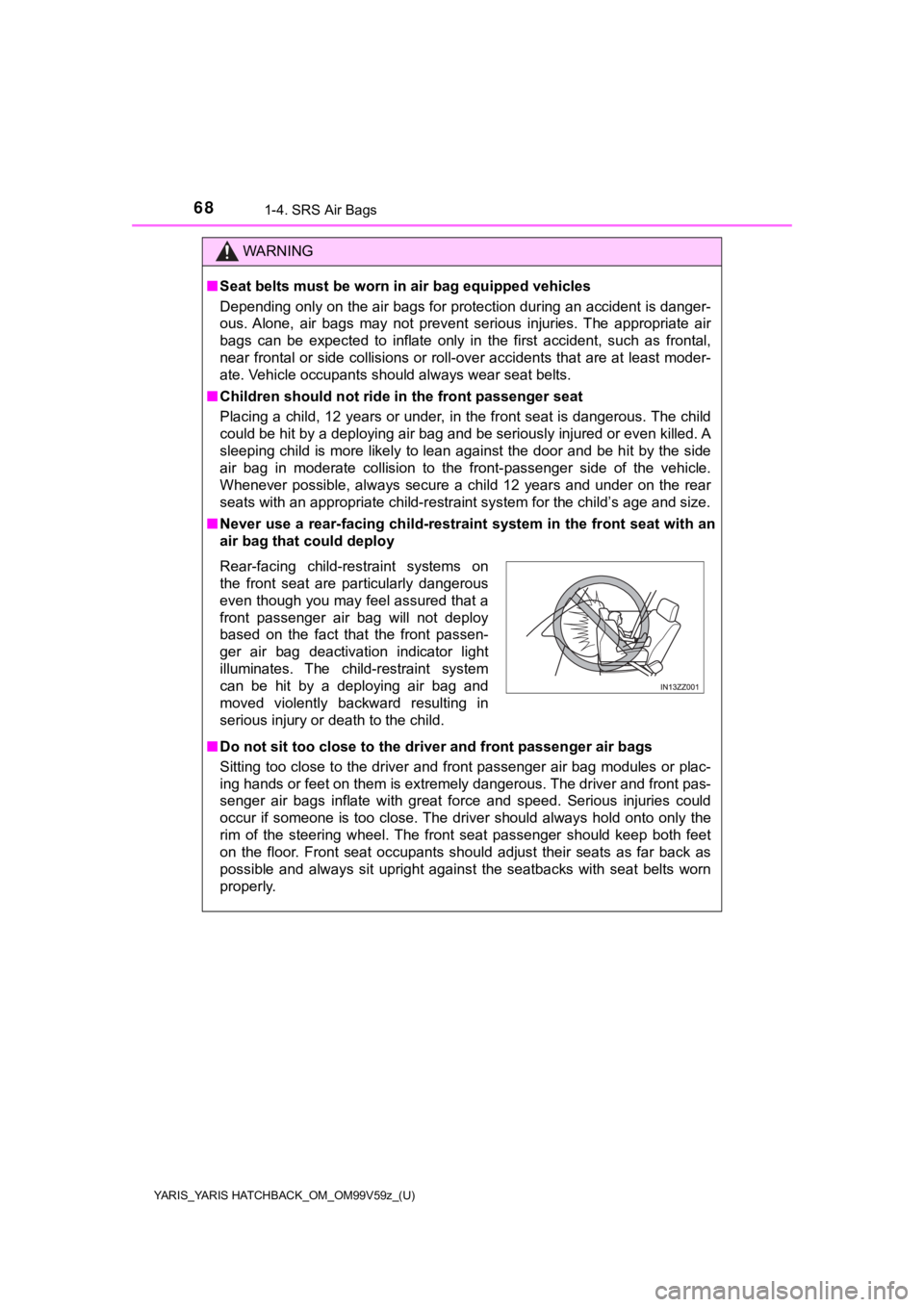
68
YARIS_YARIS HATCHBACK_OM_OM99V59z_(U)
1-4. SRS Air Bags
WARNING
■Seat belts must be worn in air bag equipped vehicles
Depending only on the air bags for protection during an acciden t is danger-
ous. Alone, air bags may not prevent serious injuries. The appr opriate air
bags can be expected to inflate only in the first accident, suc h as frontal,
near frontal or side collisions or roll-over accidents that are at least moder-
ate. Vehicle occupants should always wear seat belts.
■ Children should not ride in the front passenger seat
Placing a child, 12 years or under, in the front seat is danger ous. The child
could be hit by a deploying air bag and be seriously injured or even killed. A
sleeping child is more likely to lean against the door and be h it by the side
air bag in moderate collision to the front-passenger side of th e vehicle.
Whenever possible, always secure a child 12 years and under on the rear
seats with an appropriate child-restraint system for the child’s age and size.
■ Never use a rear-facing child-restraint system in the front sea t with an
air bag that could deploy
■ Do not sit too close to the driver and fron t passenger air bags
Sitting too close to the driver and front passenger air bag modules or plac-
ing hands or feet on them is extremely dangerous. The driver an d front pas-
senger air bags inflate with great force and speed. Serious injuries could
occur if someone is too close. The driver should always hold on to only the
rim of the steering wheel. The front seat passenger should keep both feet
on the floor. Front seat occupants should adjust their seats as far back as
possible and always sit upright against the seatbacks with seat belts worn
properly.
Rear-facing child-restraint systems on
the front seat are particularly dangerous
even though you may feel assured that a
front passenger air bag will not deploy
based on the fact that the front passen-
ger air bag deactivation indicator light
illuminates. The child-restraint system
can be hit by a deploying air bag and
moved violently backward resulting in
serious injury or death to the child.
Page 69 of 572

YARIS_YARIS HATCHBACK_OM_OM99V59z_(U)
691-4. SRS Air Bags
1
Essential Safety Equipment
WARNING
■Sit in the center of the seat and wear seat belts properly
Sitting too close to the side air bag modules or placing hands on them, or
sleeping up against the door or hanging out the windows is extr emely dan-
gerous. The side and curtain air bags inflate with great force and speed
directly expanding along the door on the side the car is hit. S erious injury
could occur if someone is sitting too close to the door or lean ing against a
window, or if rear seat occupants grab the sides of the front s eatbacks. Give
the side and curtain air bags room to work by sitting in the ce nter of the seat
while the vehicle is moving with seat belts worn properly.
■ Do not attach objects on or around the area where driver and fr ont pas-
senger air bags deploy
Attaching an object to the driver and front passenger air bag m odules or
placing something in front of them is dangerous. In an accident, an object
could interfere with air bag inflation and injure the occupants .
■ Do not attach objects on or around the area where a side air ba g
deploys
Attaching objects to the front seat in such a way as to cover t he outboard
side of the seat in any way is dangerous. In an accident the ob ject could
interfere with the side air bag, which inflates from the outboa rd side of the
front seats, impeding the added protection of the side air bag system or
redirecting the air bag in a way that is dangerous. Furthermore , the bag
could be cut open releasing the gas.
Do not hang net bags, map pouches, backpacks with side straps o r any
other objects on the front seats. Never use seat covers on the front seats.
Always keep the side air bag modules in your front seats free t o deploy in
the event of a side collision.
■ Do not attach objects on or around the area where a curtain air bag
deploys
Attaching objects to the areas where the curtain air bag activa tes such as
on the windshield glass, side door glass, front and rear window pillars and
along the roof edge and assist grips is dangerous. In an accide nt the object
could interfere with the curtain air bag, which inflates from t he front and rear
window pillars and along the roof edge, impeding the added prot ection of
the curtain air bag system or redirecting the air bag in a way that is danger-
ous. Furthermore, the bag could be cut open releasing the gas.
Do not place hangers or any other objects on the assist grips. When hang-
ing clothes, hang them on the coat hook directly. Always keep the curtain air
bag modules free to deploy in the event of a side collision or roll-over acci-
dent.
Page 70 of 572

70
YARIS_YARIS HATCHBACK_OM_OM99V59z_(U)
1-4. SRS Air Bags
WARNING
■Do not touch the components of t he supplemental restraint system
after the air bags have inflated
Touching the components of the supplemental restraint system after the air
bags have inflated is dangerous. Immediately after inflation, t hey are very
hot. You could get burned.
■ Never install any front-end equipment to your vehicle
Installation of front-end equipment, such as frontal protection bar (kangaroo
bar, bull bar, push bar, or other similar devices), snowplow, o r winches, is
dangerous. The air bag crash sensor system could be affected. T his could
cause air bags to inflate unexpectedly, or it could prevent the air bags from
inflating during an accident. Front occupants could be seriously injured.
■ Do not modify the suspension
Modifying the vehicle suspension is dangerous. If the vehicle’s height or the
suspension is modified, the vehicle will be unable to accurately detect a col-
lision or roll-over accident resulting in incorrect or unexpect ed air bag
deployment and the possibility of serious injuries.
■ To prevent false detection by t he air bag sensor system, heed t he fol-
lowing
● Do not use tires or wheels other than those specified for your To y o t a :
Use of any tire or wheel other than those specified for your To yota (P. 553)
is dangerous. Use of such wheels will prevent the vehicle’s acc ident detec-
tions system from accurately detecting a collision or roll-over accident result-
ing in incorrect or unexpected air bag deployment and the possi bility of
serious injuries.
● Do not overload your vehicle:
Overloading your vehicle is dangerous as it could prevent the a ir bag
crash sensor system from accurately detecting a collision or roll-over acci-
dent resulting in incorrect or unexpected air bag deployment an d the pos-
sibility of serious injuries. The gross axle weight rating (GAW R) and the
gross vehicle weight rating (GVWR) for your vehicle are on the Motor
Vehicle Safety Standard Label on the driver’s door frame. Do not exceed
these ratings.
● Do not drive the vehicle off-road:
Driving your Toyota off-road is dangerous because the vehicle h as not
been designed to do so. Driving the vehicle off-road could prevent the air
bag crash sensor system from accurately detecting a collision o r roll-over
accident resulting in incorrect or unexpected air bag deploymen t and the
possibility of serious injuries.